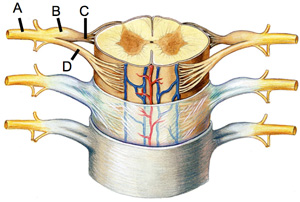IPHY 3410
Instructor: Dr. Leif Saul
Fall 2023

IPHY 3410Instructor: Dr. Leif Saul
|
 |
1. The deep gray matter of the cerebrum has abundant:
A. Multipolar neurons
B. Unipolar neurons
C. Oligodendrocytes
D. Schwann cells
E. All of the above
2. Betty suffered a stroke, preventing her from smiling on the right side of her face. The stroke occurred in the:
A. Left frontal lobe
B. Right frontal lobe
C. Left parietal lobe
D. Right parietal lobe
3. Which brain region is involved in receiving and interpreting information from the somatic sensory division of the PNS?
A. Somatosensory cortex
B. Temporal lobe
C. Occipital lobe
D. A and B
E. All of the above
4. Neurons that have their cell body in the dorsal horn of the spinal cord:
A. Are sensory neurons
B. Are visceral motor neurons
C. Are somatic motor neurons
D. Secrete neurotransmitters onto unipolar neurons
E. Receive neurotransmitters from unipolar neurons
| 5. Identify a region that has only motor neurons (no sensory neurons or interneurons). A. A B. B C. C D. D E. B and C |
 |
6. The drug atropine, which blocks the effects of the parasympathetic nervous system, can be used to increase heart rate in cardiac patients. What other effect(s) would you expect this drug to have?
A. Sweaty skin
B. Decrease blood flow to the skin
C. Dry mouth
D. All of the above
E. None of the above
7. Sometimes crystals from the maculae break off and float into the semicircular ducts. This would probably cause what symptom?
A. Feeling like you are spinning
B. Feeling like you are tilted to one side
C. Ringing in the ears
D. Feeling like you are moving faster and faster
E. Pain in the middle ear
8. Which condition(s) is/are likely to occur in an eye that is
farsighted (unable to focus on near objects)?
A. The cornea is too flat
B. The ciliary body is overworked
C. The eye is too short
D. A and C
E. All of the above
9. The best way to see a very dim star at night is to:
A. Look straight at the star, relaxing your ciliary body
B. Look straight at the star, contracting your ciliary body
C. Look to one side of the star with both eyes
D. Try to focus one eye on the star and the other eye to one side of the star
E. Squint your eyelids while looking directly at the star
10. Place the structures in the correct order in which fluid travels from blood to urethra (some steps may be missing; also, assume no absorption or resorption occurs):
A. Glomerulus -> glomerular capsule -> distal convoluted tubule -> urethra -> urinary bladder
B. Glomerular capsule -> glomerulus -> proximal convoluted tubule -> ureter -> urinary bladder
C. Loop of Henle -> collecting duct -> urinary bladder -> ureter -> urethra
D. Loop of Henle -> distal convoluted tubule -> collecting duct -> urinary bladder -> urethra
E. None of the above
11. Most testicular cancers occur in the:
A. Cells that nourish the developing sperm
B. Cells that produce testosterone (hormone)
C. Cells that divide to form new sperm
D. Connective tissue
E. Blood vessels
ANSWERS:
1. A
2. A
3. E
4. E
5. D
6. C
7. A
8. E
9. C
10. D
11. C